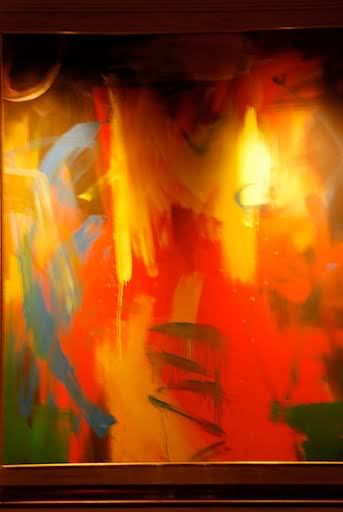Learning opportunity... for me. :-)
#1
Learning opportunity... for me. :-)
This is a shot of a large painting by Clay Spone that I have in my dining room.
I'm trying to learn to shoot in low light using the manual settings on my D80. I suck pretty bad, but the nice thing about that is that it is a chance to learn something.
I'm a huge fan of abstract expressionist art. This genre really lends itself well to being shot in lower light, to my eyes at least, but I'm not so hot at doing it.
I had the ISO ratcheted up to 1k, I believe...
The painting looks dull, and there seems to be too much reflection. The colors on this painting are very deep and rich, but it really doesn't show here. Do I need to consider a secondary light source, better flash?
For such settings and subjects, any pointers?

I'm trying to learn to shoot in low light using the manual settings on my D80. I suck pretty bad, but the nice thing about that is that it is a chance to learn something.
I'm a huge fan of abstract expressionist art. This genre really lends itself well to being shot in lower light, to my eyes at least, but I'm not so hot at doing it.
I had the ISO ratcheted up to 1k, I believe...
The painting looks dull, and there seems to be too much reflection. The colors on this painting are very deep and rich, but it really doesn't show here. Do I need to consider a secondary light source, better flash?
For such settings and subjects, any pointers?

#2
It's not so much the camera but the lighting. If you have to, turn off those lights and use a flash and bounce. Is your ceiling white? Back wall white? That's perfect for a bounce. Powerful source of light directed at either ceiling or wall (or whatever large-ish white thing you can find), adjust your white balande manually, and you will be on the right track.
ISO @ 1k sounds high, but if you're going to downsize the pic so much, it's no biggie.
ISO @ 1k sounds high, but if you're going to downsize the pic so much, it's no biggie.
#7
Wait, you're not using a tripod already? That's absolutely mandatory.
White ceiling is perfect. Light it up with either a flash or whatever light you can come up with. You can never have too much light.
Once you get the lighting right, you can start fiddling with camera settings such as white balance, ISO etc etc to improve on a solid basis.
White ceiling is perfect. Light it up with either a flash or whatever light you can come up with. You can never have too much light.
Once you get the lighting right, you can start fiddling with camera settings such as white balance, ISO etc etc to improve on a solid basis.
#9
Wait, you're not using a tripod already? That's absolutely mandatory.
White ceiling is perfect. Light it up with either a flash or whatever light you can come up with. You can never have too much light.
Once you get the lighting right, you can start fiddling with camera settings such as white balance, ISO etc etc to improve on a solid basis.
White ceiling is perfect. Light it up with either a flash or whatever light you can come up with. You can never have too much light.
Once you get the lighting right, you can start fiddling with camera settings such as white balance, ISO etc etc to improve on a solid basis.

Got a long way to go to get just close to where some of ya'll are! But at least it is fun learning!
#10
This is a shot of a large painting by Clay Spone that I have in my dining room.
I'm trying to learn to shoot in low light using the manual settings on my D80.
I had the ISO ratcheted up to 1k, I believe...
The painting looks dull, and there seems to be too much reflection. The colors on this painting are very deep and rich, but it really doesn't show here. Do I need to consider a secondary light source, better flash?
For such settings and subjects, any pointers?
I'm trying to learn to shoot in low light using the manual settings on my D80.
I had the ISO ratcheted up to 1k, I believe...
The painting looks dull, and there seems to be too much reflection. The colors on this painting are very deep and rich, but it really doesn't show here. Do I need to consider a secondary light source, better flash?
For such settings and subjects, any pointers?
Thanks




